Lenten Pilgrimage and Heritage Tour
The Greenbelt Chapel organized a Lenten Pilgrimage and Heritage Tour. We decided to join and jump-start one of the practices during Lenten Season--visiting seven churches and praying the Stations of the Cross.Assembly at the Greenbelt Chapel in Makati City is 6AM, and departure time is 6:30AM. As expected, we left Makati around 6:50AM. (not bad, considering...) There was some drizzle that morning, which I consider some sort of "blessing" from above.
We are a big group as we were able to occupy two (2) big buses. Each bus is accompanied by a priest (our chaplain for the trip) and the organizers of the pilgrimage. Our priest is Fr. Cielo, while Fr. Long leads the other bus. One of the organizers mentioned the "rules". (hehehe! Me thinks it is easier to manage small children on tours than the oldies...) On the way, we prayed the rosary--the Joyful Mysteries.
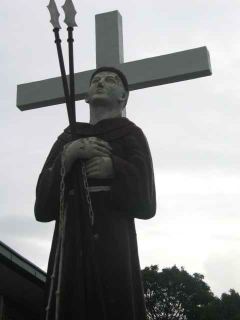
San Pedro Bautista image at Lakeview Resort (05Mar2005) 
In the middle of the resort is an image of San Pedro Bautista, a Franciscan missionary who was dragged in chains from Manila to Laguna and was stabbed with two spears on his sides.
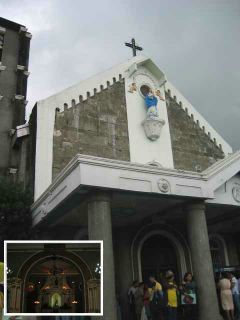
Immaculate Concepcion Church (05Mar2005) 
The Immaculate Concepcion Church is a big stone church that "was built in 1671 but was destroyed by fire in 1727. Another church of stone was constructed by Fray Domingo Mateo, OFM in 1790. The belfry and sacristy were completed in 1851 but was destroyed by an earthquake in 1863. Fray Manuel Rodriguez and Fray Guillermo Martin rebuild the church shortly after the devastation."
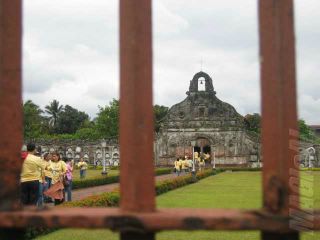
Nagcarlan Underground Cemetery (05Mar2005) 
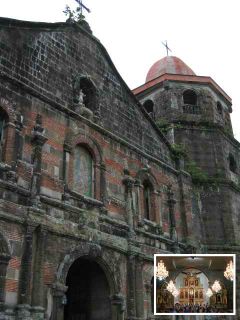
San Bartolomew Parish Church (05Mar2005) 
"This town was only a small barangay (village) when it was first colonized by Captain Juan de Salcedo (grandson of Miguel Lopez de Legazpi) and his men in 1571. The evangelization of the natives happened shortly after the arrival of the first group of Franciscans in 1589. Fr. Juan de Plasencia and Fr. Diego de Oropresa were its first missionaries. But due to lack of personnel, the town was abandoned for a while. In 1583, however, the town had its first permanent priest, Fr. Tomas de Miranda. It was in this town and in the same year that wheat was first cultivated. The first stone church was built in 1752 under its pastor, Fr. Cristobal Torres. It was destroyed by fire in 1781 but was immediately rebuilt. In 1845, the church was completely renovated under the supervision of Fr. Vicente Velloc."
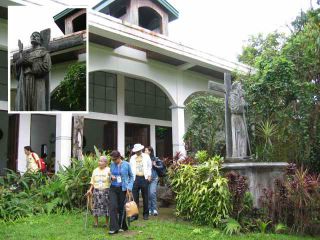
Franciscan Novitiate House (05Mar2005) 
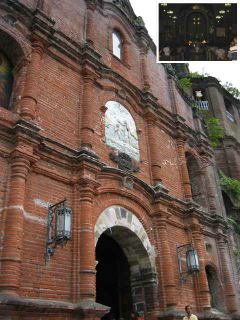
St. John the Baptist Parish Church (05Mar2005) 
"This town was just a small barangay (village) and part of Nagcarlan when it was first reduced and evangelized by Frs. Juan de Plasencia and Diego de Oropresa. It had its permanent priest, Fr. Miguel de San Lucas, in 1605. The Church's titular saint si St. John the Baptist. Tradition says that a wooden statue of St. Bonaventure in this church was venerated by the faithful for it had wept and perspired with blood in 1664."
It is also in this area where the group bought souvenirs. Liliw is known for its footwear products and native delicacies.
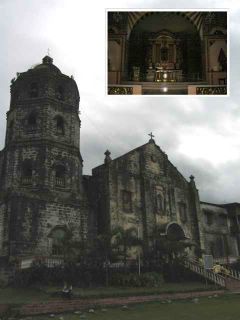
Sta. Magdalena Church (05Mar2005) 
"The town of Magdalena was knows as Ambling, a barangay of Mahayhay, until it separated from the latter in 1821. Fray Antonio Morena was its first parish priest and initiated the construction of the church. It was finished in 1854."
It is also in this church where Emilio Jacinto, known as the Brains of the Katipunan for he wrote many documents including the Kartilya ng Katipunan, ran when he was hurt. His blood can still be seen on the baldozza near the stairs.
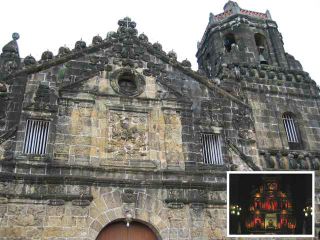
Church of St. James the Apostle (05Mar2005) 
"Paete remained a visita of Lumban until October 20, 1600 when it was transferred to the jurisdiction of Pakil, where it remained until 1602. The first church was dedicated to San Lazaro. A church and convento of stone were built in 1646 but were in ruins before 1717, when a stronger stone church and convento were built under the direction of the Fr. Francisco de la Fuente. In 1840, the convento was renovated by Fr. Luis de Nambroca and the church repaired. The church was damaged by the earthquake of 1880 and rebuilt by Fr. Pedro Gallano in 1884. The church was damaged by the earthquake of 1937. The church has been undergoing restoration since the 1970s and was declared a National Historical Site in 1981."
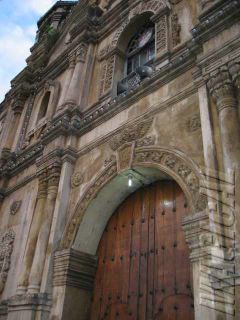
Our Lady of Sorrows Church (05Mar2005) 
"Pakil was visita of Paete until 1676 when Fr. Francisco de Barajas was assigned as permanent minister. Although permission was obtained in 1684 to reserve tribute collected over five years for the construction of the church, the foundations were not dug until 1732, during the incumbency of Fr. Fernando Haro. The complex was burnt in 1739. Work on the complex continued until 1767. An additional story was added to the bell tower in 1777. In 1840, Fr. Joaquin de Coria repaired the church. Because of a fire in 1851 which ravaged most of the town, Fr. Juan de Llanera repaired the church the following year. Fr. Juan de Dios de Villayos repaired the church roof and bell tower after it was damaged by an earthquake in 1881. The church was repaired in 1883 by Fr. Paulino Camba; damaged by the earthquake of 1937, it was repaired yet another time. During World War II, the church suffered damage and was repaired. The latest major repair was from 1980 to 1984, when a story of the bell tower was rebuilt.
"In 1788, the image of the Nuestra Señora de los Dolores or Virgen de Turumba was enshrined in the church. After the image survived the fire of 1851, devotion to the Virgin increased. The feast of the Virgen de Turumba is celebrated in September on the feast of Our Lady of Sorrows. Devotees dance throught the streets of Pakil, stumbling, walking, gyrating as they go along in imitation of the sick and maimed. In preparation for the feast, seven novenas called lupi (nine days of prayer), each honor of the sorrows of the Virgin are celebrated in the church, making this the longest novena in the Philippines. Behind the church is Bukal ng Birhen (Virgin's spring) said to have medicinal waters."
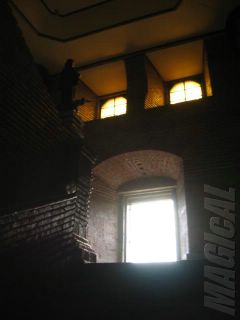
Stairs at Our Lady of Sorrows Church (05Mar2005) 
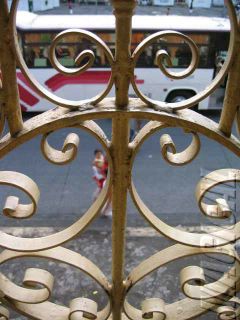
A view of our bus from a window of Our Lady of Sorrows Church (05Mar2005) 
Funny thing is, we were not supposed to go to the second floor of the church, but since someone saw me at the foot of the stairs, a small group proceeded to go upstairs... hehehehe!
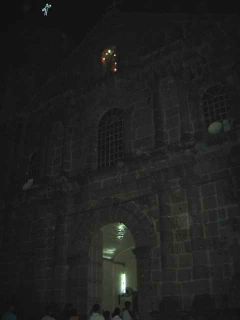
San Ildefonso Parish Church (05Mar2005) 
"Formerly a visita of Pililla and located in the foothills of the Sierra Madre, Tanay became independent from Pililla in 1606. The town was transferred to a site called San Antonio in 1620 and then to the site it presently occupes in 1640; the transfer was probably catalyzed by the Chinese uprising of 1639, when many Chinese sought refuge in the Sierra Madre. In 1680, a church and convento were built of stone. But by 1773, both were in such a state of deterioration that Fr. Ildefonso Fetanes had the older structures demolished and new ones built. The present church and convento were built from 1773 to 1783. Both structures were repaired and improved in 1851 by Fr. Antonio Santiago."
It was expected that we would be arriving at the Greenbelt Chapel around 7:30PM. But because of the beauty provided by these churches, we can't help but also be tourists during the pilgrimage. Our Lenten Pilgrimage and Heritage Tour ended around 9PM.
Note: Lest you think I have this photographic memory that can memorize all these dates and events regarding these churches, the organizers have provided us a write-up about them at the start of the tour... hehehehe!
Sidelights:
The Tau Cross. At the start of the pilgrimage, Fr. Cielo gave each one of us a Tau Cross, which, according to him is what St. Francis chose as a more ancient symbol of redemption. The last letter of the Hebrew alphabet, the tau, was transcribed as "T" in Greek. It represents the means by which Jesus Christ reversed the disobedience of the old Adam and became our Savior as the "New Adam".
Wrong bus. Since it was drizzling from time to time, a foreigner (who is part of the pilgrimage) shared his umbrella to one of our senior citizen ladies. Since he happens to ride the other bus, the lady joined him back to his bus after one of our stops. Then, she noticed that she doesn't know anybody in the bus. She immediately stepped down and went to our bus. What made the incident a lot funnier is because her friends in our bus kept on teasing her because she forgot them because of the guy... hehehehe!

6 Comments:
whoa! that was one great post there. very informative. and i can't believe that those pics were taken by your cel. malufet sya ha. parang isang church lang ang familiar sa akin. i've been to the Our Lady of Sorrows in Pakil. it is a nice church, with very rich historical background. my bestfriend is from that place. she lives near the church so whenever we go there we visit the Our Lady of Sorrows. Medyo dark nga lang pag hindi Sunday. Kinda eerie at times. ;-) sarap naman nung trip mo. i hope i could do something like that (an organized thing) kse usually nung buo pa family namin my dad brings us to 7 churches. pero kami kami lang yun and puro dito lang sa manila na simbahan. maganda din makakita ng ibang church diba...;-)
hehehe! thanks...
nde po camera ng phone ko ginamit ko, kasi it won't do justice dun sa mga kinukunan kong churches. ginamit ko po yung ever reliable kong Canon S45 Digital Camera. at para sigurado, nagdala pa ako ng isa pang back-up camera. c",)
madilim nga yung sa Our Lady of Sorrows, kaso ganda nung timing ng punta namin kasi pa-sunset na at dramatic ang dating nung church. taka nga ako bakit nagkakagulo yung mga kasama namin sa pilgrimage dun sa may tindahan. yun pala, buy sila nung bottle containing the healing water. ngek! nde tuloy ako nakakuha...
very detailed po ang story mo,dapat mag freelance writer ka nasa talent mo po,with regards sa pictures,magaling ka na po magcompose,great shots,
teynks po! at least, nde ka nakatulog habang nagmo-monologue ako sa travelogue ko... hehehehe!
maganda rin po kasi mga kinukunan na scenes kaya maganda ang dating ng pics. c",)
nice tour... i always like old churches... i may be a deviant catholic but i like the idea of pilgrimage.
Yes, it is. These old churches have a beauty all their own further enhanced by the part they play in our history.
I wonder if you really are a deviant Catholic. Most Catholics today seldom attend mass, bible studies, etc. That makes you a norm... hehehe!
I like the idea of pilgrimage, too! It's a good excuse of visiting places you've never been to, without the hassle. That's because the organizers are the ones worrying that the activity is a success. c",)
Post a Comment
<< Home